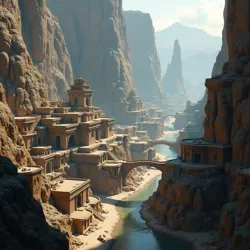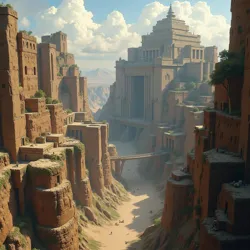Gnathos Spires: The Edge City

City built into sheer basalt and obsidian cliffs with layered, vertical architecture.
Cliffscar Canyons
Layered, carved into cliffs
Carved Basalt, Obsidian Tools
Control of trade choke point
The First Cutter
Circa 800 years ago
Highly stratified, guild-based
| Commodity | Primary Source/Production Area | Major Export Markets | Historical Significance |
|---|---|---|---|
| Carved Basalt | Lower City Workshops | Neighboring City-States, Eastern Coasts | Foundation of city's wealth and reputation |
| Obsidian Tools/Art | Obsidian Carvers' Guild Halls | Distant Lands, Wealthy Patrons | High-value export, symbol of craftsmanship |
| High Ropes/Gear | High Ropes Guild Forges | Canyon Travelers, Mountain Expeditions | Essential for vertical movement, specialized export |
| Canyon Water | Water Masters' Reservoirs | Limited External Supply | Crucial internal resource, source of internal power |
| Hardwood (Limited) | Scattered Canyon Pockets | Primarily Internal Use | Scarce resource, highly valued for construction/fuel |
Gnathos Spires is a major city situated within the formidable Cliffscar Canyons, renowned for its distinctive layered architecture carved directly into the sheer basalt and obsidian cliffs. The city occupies a series of natural and artificial terraces and spires rising from the canyon floor, presenting a striking vertical urban landscape. Its strategic position controls access through a significant choke point in the region, historically making it a vital hub for trade and defense. The unique geological setting has shaped not only the city's physical form but also its cultural identity, deeply intertwined with stonecraft, verticality, and a complex social structure reflecting its tiered layout.
The city's development is intricately linked to the challenging environment of the Cliffscar Canyons. Early settlements clung precariously to ledges and caves, gradually expanding through generations of meticulous stone carving and construction. This process, detailed in early chronicles such as the Stonecutter's Lament, reflects a profound relationship between the inhabitants and the rock face. The city's growth was not merely horizontal expansion but a deliberate vertical articulation, creating distinct districts at different elevations, each with its own character and function. This vertical organization has had lasting effects on the city's infrastructure, social hierarchy, and daily life, necessitating complex systems of lifts, stairs, and bridges to connect the various levels.
Geography and Layout
Gnathos Spires is located within the vast network of the Cliffscar Canyons, a dramatic geological formation characterized by sheer cliff faces, deep gorges, and scattered plateaus. The city proper is built primarily on and into the eastern wall of the Great Chasm, the largest and deepest canyon in the region. The immediate environment is arid, dominated by sparse, hardy vegetation clinging to rocky outcrops, contrasting sharply with the intricate stonework of the city itself. The canyons are prone to seasonal flash floods in their lower reaches and experience significant temperature variations between the sun-baked upper levels and the cooler, shaded depths.
 Dense market areas and workshops at the base of the towering canyon walls.
Dense market areas and workshops at the base of the towering canyon walls.The city's layout is defined by its vertical stratification. It comprises several distinct tiers or "spires" and a sprawling lower city built along the canyon floor where the chasm widens slightly. Access between levels is challenging, historically relying on rope-and-pulley systems and treacherous staircases carved directly into the rock. In later periods, more sophisticated mechanical lifts and reinforced bridges were constructed, facilitating movement but still emphasizing the separation between levels. The geological composition of the cliffs, primarily ancient basalt flows capped by layers of hardened ash and veins of volcanic glass (obsidian), provided the primary building materials and influenced the architectural styles.
The Spire Districts
The upper levels of Gnathos Spires, often referred to collectively as the Spire Districts, consist of structures built atop and into the highest, most defensible cliff faces and freestanding rock pillars. These districts are typically home to the city's most influential guilds, wealthy merchants, and governing bodies. The architecture here is characterized by imposing towers, fortified residences, and structures seamlessly integrated into the natural rock formations. The air is clearer, and the views across the canyons are expansive, offering a sense of detachment from the bustle and potential hazards of the lower levels.
Each Spire District often developed around a particularly prominent rock formation or a cluster of significant buildings. For instance, the district known as the Pinnacle Quarter is built around the tallest freestanding spire, accessible only by a single, heavily guarded bridge and a primary lift system. This area houses the High Council and the central archives. Another notable area is the Sky-Bridge Ward, a network of structures connected by high, arching bridges spanning gaps between spires, providing stunning vistas but also presenting unique defensive challenges. These upper districts represent the apex of Gnathos Spires' architectural achievement and social structure.
The Lower City and Canyons
Below the Spire Districts lies the Lower City, a dense, bustling area occupying the relatively flat, albeit uneven, ground at the base of the cliffs. This area is home to the majority of the city's population, including laborers, artisans, market vendors, and transient populations. The architecture here is more varied and less formal than in the upper levels, with buildings constructed from rough-cut stone, timber, and sometimes even salvaged materials. The streets are narrow and winding, often overshadowed by the immense cliffs rising on either side.
The Lower City is the economic heart of Gnathos Spires, containing the primary markets, workshops, and warehouses. It is also the point of connection for trade routes entering the city through the canyon passes. Life in the Lower City is more exposed to the elements and the dangers of the canyons, including rockfalls and flash floods. Several smaller settlements and outposts are scattered deeper within the Cliffscar Canyons, connected to the Lower City by trails and riverbeds, forming a wider network that supports the city through resource extraction and agriculture in sheltered pockets. These outlying areas often face greater challenges from raiders and the harsh environment, acting as a buffer for the main city.
History
The history of Gnathos Spires is a long and complex narrative of adaptation, conflict, and resilience in a challenging environment. Archaeological evidence suggests human habitation in the Cliffscar Canyons dates back millennia, with early peoples utilizing the caves and rock shelters for protection. The foundations of what would become Gnathos Spires were laid by disparate groups of cliff-dwellers who began to coordinate their efforts for mutual defense and resource management. These early communities relied heavily on hunting, gathering, and small-scale agriculture in the scattered fertile pockets within the canyons.
 Massive elevator system connecting the distinct levels of the tiered city.
Massive elevator system connecting the distinct levels of the tiered city.The strategic importance of the location became apparent as trade routes began to develop across the wider region. The Cliffscar Canyons represented a significant barrier, and any power controlling the passages through it could exert considerable influence. The early settlements in the area began to consolidate, driven by the need to defend themselves against nomadic raiders and competing groups seeking control of the trade routes. This period saw the beginnings of the intricate stone defenses and vertical structures that characterize the city today, as inhabitants learned to use the natural topography to their advantage.
Founding and Early Development
The formal founding of Gnathos Spires is often attributed to the unification of several prominent cliff-dwelling clans under the leadership of the legendary figure known as the First Cutter, circa 800 years ago. This period marked a shift from scattered settlements to a more organized, centralized entity focused on communal defense and the systematic development of the city's unique vertical architecture. Early construction focused on fortifying the most accessible points and establishing reliable, albeit rudimentary, vertical transit systems.
The early city was largely self-sufficient, relying on resources harvested from the canyons and surrounding plateaus. The development of sophisticated stone-carving techniques and the discovery of valuable mineral deposits within the cliffs, particularly high-quality basalt for building and veins of volcanic glass for tools and trade, spurred economic growth. This era also saw the formation of the first guilds, organizations of craftsmen and laborers who played a crucial role in the city's construction and maintenance. The Chronicles of the Cliff-Dwellers provide fragmented accounts of this period, detailing the challenges of building in such a harsh environment and the social structures that emerged to support the collective effort.
The Period of Consolidation
Following the initial founding, Gnathos Spires entered a long period of consolidation and expansion. The city's control over the canyon passes solidified, allowing it to tax passing trade caravans and establish itself as a regional power. This economic prosperity fueled further architectural development, including the construction of larger, more permanent structures and the improvement of vertical transport systems. The Spire Districts began to take shape, becoming the residences of the burgeoning merchant class and the increasingly powerful guilds.
This era was not without conflict. Gnathos Spires faced numerous challenges from external powers seeking to break its control over the trade routes, as well as internal strife between competing guilds and social strata. Notable conflicts include the Stone Wars, a series of skirmishes with rival groups vying for control of the canyon entrances, and the Guild Uprisings, periods of social unrest driven by inequalities between the upper and lower city populations. Despite these challenges, Gnathos Spires maintained its independence and continued to grow, solidifying its reputation as an impregnable fortress city. The development of complex water collection and storage systems, essential for survival in the arid canyons, was a major achievement of this period, allowing the city to sustain a larger population.
Modern Era and Challenges
In the modern era, Gnathos Spires remains a significant regional center, though its role has evolved. While still important for trade, the development of alternative routes and modes of transport has reduced its absolute dominance over canyon traffic. The city has increasingly diversified its economy, with specialized crafts, particularly those utilizing volcanic glass and intricately carved stone, becoming important exports. The unique architecture and history have also made it a destination for scholars and a limited number of intrepid travelers.
Contemporary challenges include maintaining the aging vertical infrastructure, managing the environmental impact of a large population in a fragile ecosystem, and addressing persistent social inequalities between the upper and lower city. The rise of new political and economic powers in the wider region, such as those potentially involved in the complex negotiations detailed in the Sunken Plains Concordat, require Gnathos Spires to navigate a shifting geopolitical landscape. The city government, a council composed primarily of guild masters and representatives from prominent families, faces the task of balancing tradition with the need for modernization and reform.
Culture and Society
The culture of Gnathos Spires is deeply influenced by its unique environment and history. The constant presence of the towering cliffs and the intricate, layered city structure fosters a sense of both verticality and interdependence. Society is highly stratified, largely mirroring the physical layout of the city, with distinct social groups often residing on different levels. There is a strong emphasis on craft, skill, and precision, reflecting the city's origins in stone carving and construction.
 Imposing towers and structures integrated into the highest, most defensible cliff faces.
Imposing towers and structures integrated into the highest, most defensible cliff faces.Social life often revolves around the guilds, which function not only as professional organizations but also as social and political units. Family ties remain important, particularly among the older, established clans, but guild affiliation often crosscuts or supplements familial loyalty. Festivals and ceremonies frequently incorporate elements related to stone, height, and the city's founding myths, celebrating the collective effort required to build and maintain Gnathos Spires. Despite the social stratification, there is a shared pride in the city's unique identity and its historical resilience.
Guilds of the Spires
Guilds are central to the social, economic, and political life of Gnathos Spires. These organizations govern specific trades and crafts, setting standards, training apprentices, and regulating production. They also serve as mutual aid societies and, historically, as militias responsible for defending specific sections of the city. Membership in a guild often determines one's social status and access to resources and political influence.
Prominent guilds include the Stonecutters' Guild, historically the most powerful, responsible for the city's foundational architecture; the Obsidian Carvers, renowned for their intricate work with volcanic glass; the High Ropes Guild, essential for maintaining the vertical transport systems; and the Water Masters, who oversee the critical water collection and distribution network. Each guild maintains its own halls, rules, and traditions, often located in specific districts of the city corresponding to their members' residences or workshops. The masters of the most influential guilds form the core of the city's ruling council, giving these organizations significant political power.
Way of Life
Daily life in Gnathos Spires varies significantly depending on one's social standing and residence level. In the Lower City, life is often characterized by crowded markets, bustling workshops, and a strong sense of community among neighbors. Access to resources like fresh water and sunlight can be more challenging here, requiring greater reliance on communal infrastructure. The rhythm of life is often dictated by the demands of labor and trade.
In the Spire Districts, life is generally more comfortable and secluded. Residences are larger and more private, and access to amenities is more reliable. Social interactions tend to be more formal, centered around guild functions, council meetings, and private gatherings. Movement between levels is a daily reality for many, requiring reliance on the lifts and bridges. Despite the differences, a shared experience of living within the monumental scale of the canyons and the tiered city structure permeates all levels of society, fostering a unique perspective on the world. The challenges of the environment, from dust storms to the risk of rockfalls, are constant reminders of the power of nature and the fragility of human endeavor.
Economy and Trade
The economy of Gnathos Spires has historically been based on its strategic control of the Cliffscar Canyon passes, allowing it to profit from overland trade. While this remains important, the city has also developed a robust economy centered on specialized crafts, resource extraction, and increasingly, services. The unique resources of the canyons, particularly high-quality basalt and obsidian, form the basis of significant industries.
Trade routes converging on Gnathos Spires bring goods from distant lands, including textiles from the southern plains, metals from mountain regions, and exotic spices from coastal areas. In return, Gnathos Spires exports its famous carved stone goods, obsidian tools and art objects, and specialized equipment related to vertical movement and construction. The city's markets are vibrant and diverse, reflecting the confluence of goods and peoples from across the region. The guild system plays a crucial role in regulating economic activity, controlling production, quality, and trade within their respective domains.
The table above illustrates some key commodities in the economy of Gnathos Spires. While trade remains vital, internal economic activity related to construction, maintenance of infrastructure, and the provision of services to the population is also significant. The city's economy is a complex interplay between external trade, internal production, and the unique demands of maintaining a city built in such an environment.
Notable Structures and Landmarks
Gnathos Spires is home to numerous impressive structures, testaments to the skill of its builders and the city's long history. These landmarks are often integrated into the natural rock formations, blurring the lines between architecture and geology. Many serve practical purposes related to defense, infrastructure, or guild functions, while others hold cultural or historical significance.
Among the most famous is the Great Lift, a massive counterweighted elevator system that provides the primary connection between the Lower City and the highest Spire Districts. Its construction was a monumental undertaking, requiring generations of effort and the combined expertise of multiple guilds. Another iconic structure is the Sky-Bridge, a series of elegant, arching bridges spanning vast gaps between several prominent spires, offering breathtaking views and serving as crucial high-level pathways. The Pinnacle Library, housed within the solid rock of the tallest spire, contains a vast collection of historical documents, guild records, and scholarly texts, though access is often restricted. The Deep Market, located in a wide cavern in the Lower City, is the largest and busiest marketplace, a chaotic but vital hub of commerce and social interaction.
Defense and Security
The defense of Gnathos Spires is based on its inherently defensible location and centuries of architectural fortification. The sheer cliffs provide natural barriers, making a direct assault extremely difficult. Access is primarily limited to the canyon entrances, which are heavily fortified with layers of walls, gates, and watchtowers carved into the rock face. The vertical nature of the city allows defenders on higher levels to rain projectiles down upon attackers in the lower areas.
Internal security is maintained by a combination of guild militias, particularly the Stonecutters and High Ropes guilds who control key access points and structures, and a city watch answerable to the council. Movement between levels is monitored, and access to the highest districts is often restricted, particularly during times of tension. While the city has proven largely impregnable to external military force, internal security challenges, such as smuggling, theft, and occasional unrest in the Lower City, require constant vigilance. The city's defense strategy emphasizes controlling key choke points and utilizing the unique topography to channel and neutralize threats.
Connections to the Wider World
Despite its isolated location within the Cliffscar Canyons, Gnathos Spires maintains significant connections to the wider world, primarily through trade and diplomacy. The canyon passes it controls are part of a larger network of ancient trade routes connecting distant regions, including the fertile river valleys to the south, the arid plateaus to the west, and the coastal city-states to the east. Caravans laden with goods regularly arrive at the city's gates, bringing news and cultural influences from afar.
Gnathos Spires engages in diplomatic relations with neighboring powers, navigating complex political landscapes. Its strategic importance has led to alliances and rivalries with various kingdoms and city-states throughout its history. The city's unique cultural products, particularly its stone and obsidian crafts, are valued in distant markets, contributing to its reputation. Scholars and adventurers occasionally visit, drawn by the city's history, architecture, and the mysteries of the Cliffscar Canyons. The city's involvement, however tangential, in broader regional agreements like the Sunken Plains Concordat, underscores its continued relevance in the geopolitical arena, demonstrating that even a city built on the edge of the world is inextricably linked to the currents of the wider world.